Last updated: April 20, 2021
Thing to Do
Explore the Dunes

NPS/Patrick Myers
The centerpiece of Great Sand Dunes National Park and Preserve is the 30-square-mile (78-square-km) dunefield, featuring the tallest dunes in North America. Because there are no trails, you can venture out anywhere you'd like to discover unusual insects, plants, wildlife tracks, ripples, and sand grains of every color. In warmer months, watch for one of 7 species of endemic insects, found nowhere else in the world, that are specially adapted to the extreme environment here.
During summer, plan your dunes time for early morning or evening to avoid sand surface temperatures of 150 degrees F, or thunderstorms with lightning and wind. Boots with long pants work best to keep sand out of your shoes. Walk on the tops of ridges for the firmest footing. It's very difficult for an adult to get lost in the dunes, because you can see the mountains, entrance road, and visitor center for reference.
If you have time and energy, hike High Dune on First Ridge (692 feet/211 m), Star Dune (741 feet/226 m) or Hidden Dune (742 feet/226m).
How were these dunes formed? Discover the answer in this Introduction to the geology of Great Sand Dunes.
You can also discover geological processes at your feet! Look and feel for sinous ripples in the dunes. Lighter-colored, coarse sand made of sedimentary and metamorphic rocks from the nearby Sangre de Cristo Mountains forms ripples that slowly move over darker, fine-grained volcanic sand from the distant San Juan Mountains.
You may also notice streaks or patches of black magnetite sand as you explore. This mineral is similar to iron, but never rusts. It gains its strong magnetic charge when lightning strikes magnetite mineral deposits in the Sangre de Cristo and San Juan Mountains. These deposits erode into sand that arrives in the dunes by wind and water, and the sand retains its magnetic charge. While this sand can be picked up with a magnet, please leave it here for others to also enjoy and study.
Occasionally, visitors find rough tubes of dark glass on the sand formed from lightning. Learn about the formation of fulgurites in this short article. All natural and cultural objects in national parks are protected by federal law; you may pick them up and study them, but please leave them for other visitors to also enjoy.
You may hear the dunes make sounds as you hike - listen to a recording and learn more about the 'singing sands'!
More topics on Great Sand Dunes
Introduction to Plants of Great Sand Dunes
Introduction to Birds of Great Sand Dunes
Introduction to Endemic Insects of Great Sand Dunes
Introduction to Mammals of Great Sand Dunes
Introduction to Amphibians of Great Sand Dunes
Introduction to Reptiles of Great Sand Dunes
Introduction to Fish of Great Sand Dunes
Young children are lower to the ground, and may experience heat exhaustion or burns from the hot sand surface if hiking in mid-day during summer months. Avoid the dunes during the hottest part of the day in summer. Instead, plan your dunes time for morning or evening, and spend the afternoon hours in forested areas or by water.
A limited number of sand wheelchairs are available for loan at the visitor center. One is designed for small adults, and one for small children. Although a helper is required to push the chairs through soft sand, large inflatable tires make short trips across the sand possible.
Please keep these guidelines in mind when using sand wheelchairs:
- The adult chair is not suitable for large adults, or for an adult holding a child. The balloon tires can only support standard adult weight limits.
- Chairs should be borrowed only by those who need a chair for access.
- You'll need to leave an ID at the visitor center to ensure that the closet key is returned. Return the chairs at least 1/2 hour before the visitor center closes.
- Sand wheelchairs should only go on sand or smooth pavement, never on rocks or cactus which may pop the balloon tires.
- While the chairs are easy to push in the wet, firm sand along Medano Creek, pushing the chairs through dry, soft sand takes some strength and perseverance, even with balloon tires. During dry times of the year, the sand may become especially soft.
- Reserve a wheelchair in advance by calling the visitor center at 719-378-6395.
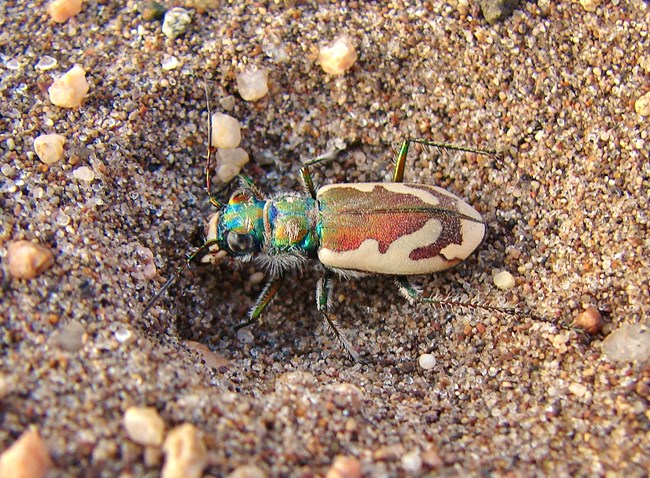
NPS
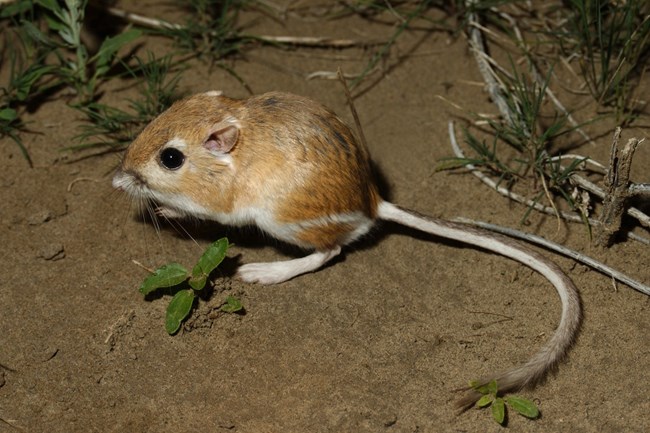
NPS
While a number of mammals visit the dunes on occasion, only Ord's kangaroo rats can live their entire lives in the main dunefield. They collect seeds from various grasses and sunflowers, and hide them in moist sand below the surface. After a couple of days collecting moisture, the seeds now provide a little water to these rodents that can live their entire lives without drinking. Kangaroo rats are so named because they can jump up to 5 feet (1.5m) in the air to avoid their many predators. If jumping doesn't work, they may kick sand in their predator's face.
They are active year-round, but are nocturnal; look for them in the dunefield after dark.
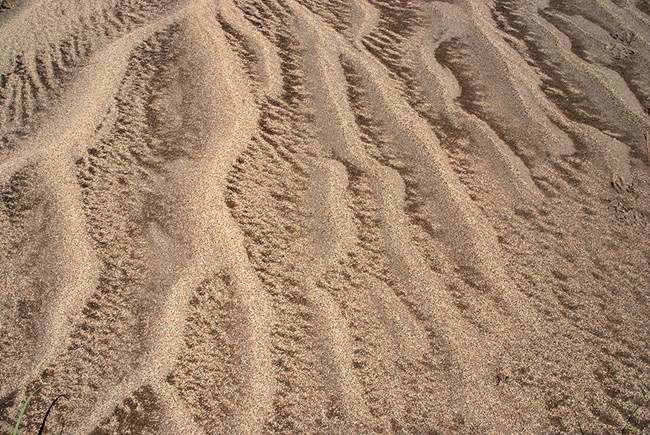
NPS
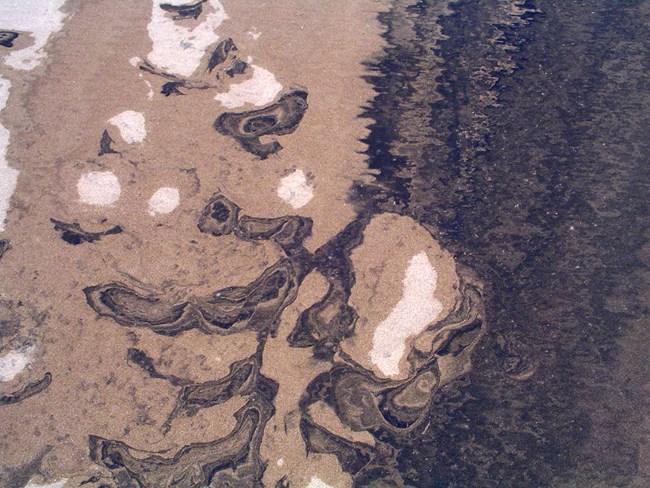
NPS/Scott Hansen
While this sand can be picked up with a magnet, please leave it here for others to also enjoy and study. All natural and cultural objects in national parks are protected by federal law.
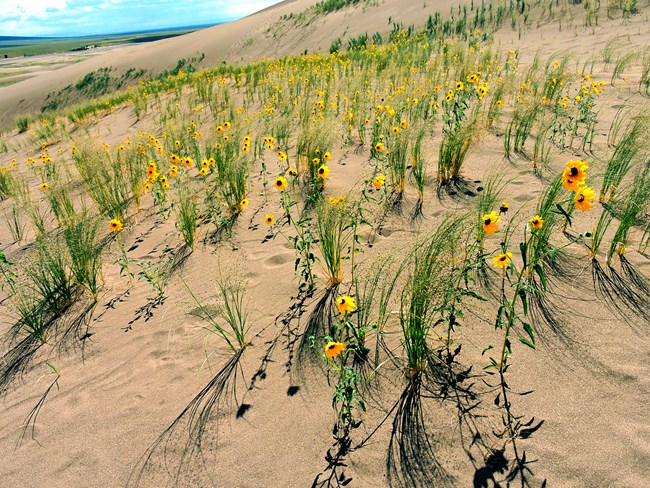
NPS/Patrick Myers
In wet summers, thousands of prairie sunflowers can bloom on the dunes, as well as in the surrounding grasslands. Peak bloom is around mid-August.
There are 16 plants that can grown on the dunes. Other common plants to look for are:
- Scurfpea - a small, leafy plant with purple blossoms and green peas
- Indian ricegrass - grasses with small black rice grains
-
Blowout grass - grasses with jagged tufts at their tip, often making circles in the sand as the slender lower blades blow in the wind

NPS/Patrick Myers
High Dune on First Ridge
The high dune on the first ridge is neither the highest in elevation nor the tallest in the dunefield, but it looks that way from the main parking lot. This is the most common destination in the dunefield, providing a great view of the entire dunefield. It is about 692 feet (210 m) from base to top. Cross a half-mile (1km) of the Medano Creek bed, then zigzag up along ridgelines to reach it.
Average round trip hiking time for High Dune is 2 hours, but plan to take as much as 4 hours to hike roundtrip if not acclimated to the high altitude and lower oxygen level. In summer months, always plan your dunes time for morning or evening to avoid 150 degree F sand and thunderstorms with lightning.

NPS/Andrew Valdez
Hidden Dune
Hidden Dune is currently the tallest dune in the dunefield at 742 feet/226 m. Named because it's remote and hidden from the main visitor use area, it is also one of the least-hiked dunes in the dunefield.
Hike 3 miles (4.8 km) straight north from the main Dunes Parking Lot. This dune is located at center right in the dunefield.

NPS/Patrick Myers
Star Dune
This dune stands about 741 feet (225 m) from base to summit. While it can be hiked from the summit of the High Dune on the first ridge, it's more direct, and less up and down, to access it via its base along the Medano Creek bed. From the Dunes Parking Lot, hike about 2 miles (3.2 km) south down the Medano Creek bed until the massive pyramid-shaped Star Dune comes into view. Follow a ridge to its summit.This hike is 6 miles round trip; average round trip hiking time is 6 hours. Plan to take as much as 9 hours if not acclimated to the high altitude and lower oxygen level.
